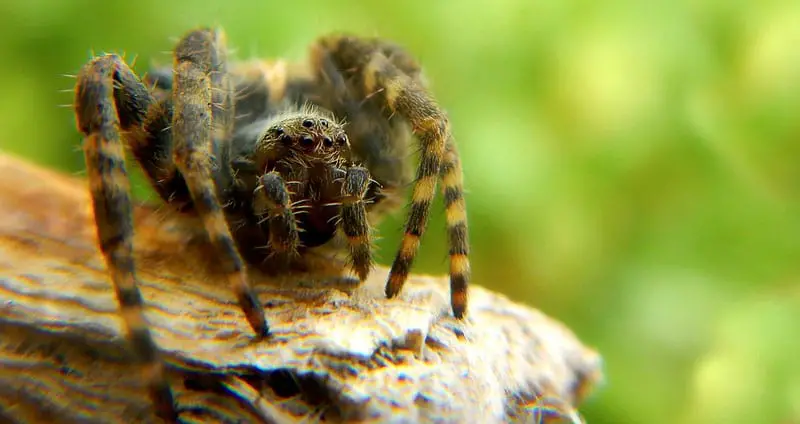Spiders are known as creepy, crawly, silent creatures that go about their lives with stealth and care. Their small size and calculated movements make them seem like perfect hunters in the great outdoors.
Due to this, you wouldn’t think that these creatures are capable of making several different sounds — some of them pretty crazy!
This post is going to go in-depth about all of the different noises that spiders make in their daily lives and what exactly they mean.
Table of Contents
Do Spiders Make Noise?
While you may not have ever experienced it, yes, spiders can make noise! There are several different noises that spiders can make, and there are a variety of reasons behind why they make those noises!
Any time an animal makes a noise, there’s usually a reason behind it. More complex animals like dogs are able to convey very complex emotions through the sounds that they make.
Spiders are much simpler creatures without complex thought, so the sounds that they make aren’t as complicated or meaningful. That doesn’t mean that they’re without utility, though.
It should be noted that all spiders don’t make the same noises. Some species may make similar noises, and others may make entirely different noises — there’s a lot of variance.
However, there are some very prominent spider noises that we absolutely need to highlight within this post; noises that are very meaningful to the survival of the spider.
What Noises Do Spiders Make?
The noises that spiders make depend on the species that’s making the noise. This means that there are a bunch of different noises that range from subtle to quite prominent.
Despite this, spider noises can be classified under two main categories, and those are purring and hissing.
You may be able to make assumptions about what each of those sounds mean within the spider world, and there’s a good chance that you may be right. While some noises are strictly for spider-to-spider communication, others are more of a universal language as you’ll see.
Spider Purring
Purring is a sound that animals make that is generally associated with pleasure, happiness, and contentment. Everyone knows that cats purr, but not many people know that spiders also possess the ability to make this noise.
This purring can be heard by humans, but it can be heard in a whole different way by other spiders.
The most prominent audible purring sound is made by wolf spiders by creating vibrations around themselves.
This works due to the wold spider standing on material that can easily carry vibrations, such as dried leaves, and rubbing their pedipalps together to create vibrations. These vibrations are audible to humans and carry through leaves to other spiders.
This how the wolf spider finds mates! Female wolf spiders are able to pick up on the vibrations and determine whether or not they’d like to mate with the male. In fact, they’re able to convert these vibrations to much clearer and more defined sounds.
This is unique because the spider isn’t making noise from its body like a cricket or katydid does, but instead it’s using its environment to create these sounds.
Another spider that uses this technique is the jumping spider. These tiny spiders have a very intricate mating ritual that involves a purring that isn’t heard by human ears.
Male jumping spiders can mate many different times, but females can only mate once — meaning that the male needs to make a convincing case for himself.
During this mating ritual, you’re able to see the spider dancing around and methodically moving its legs. What you can’t observe, however, is the noise that accompanies this dancing.
This spider beats together its abdomen and its cephalothorax to create vibrations that travel through the ground to a female. This is different from the wolf spider because these vibrations aren’t audible to us, and they’re made from the spider’s body alone — not rustling leaves.
While this can’t be heard with our ears alone, it does produce a noise that can be observed by using a laser vibrometer to convert the vibrations that are created into audible sound waves.
This is essentially what the female spider is hearing through the vibration-sensitive ears on her legs.
Spider Hissing
While spiders create purring noises to help them with their mating attempts, they also create noises that have the exact opposite purpose — to scare predators away. Some spiders are tough creatures, but they still much prefer to avoid confrontation altogether as opposed to getting into a potentially deadly fight.
So, hissing noises let potential predators know to not try anything.
This hissing is largely done through something called stridulation, which is the act of producing sound by rubbing together body parts. Spiders can’t create hissing sounds out of their mouths, so they get a bit creative with their strategy.
This behavior and sound is largely present with tarantulas — particularly the aggressive species that possess the ability to pack a devastating punch.
It’s created by rubbing the setae hairs of the front legs and pedipalps together in either a slow or fast movement. This is demonstrated by the video of a Goliath Birdeater Tarantula below.
This hissing noise can either be made during walking (as shown above), or when a spider is in a defensive/attack stance. When it’s made as a spider is walking, the hissing is more of a soft warning.
However, when the spider is in its attack stance, it appears much more threatening. At this point, if the spider keeps feeling like its threatened, it’s likely that it’s close biting the perceived threat.


I LOVE SPIDERS! My daughter used to have a PET tarantula. She would take it out of its fantastic habitat and hold it, allow it to crawl up her arm, onto her face even. I did the same. No problem!